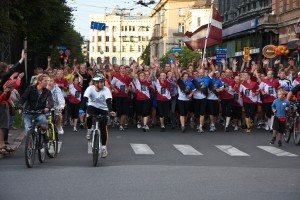
Two million held hands from Tallinn to Vilnius to protest the Soviet occupation of the Baltic states in 1989.
RIGA — On August 23, 1989 some 2 million residents across the Baltic states joined hands as part of a non-violent protest action calling for restoration of independence for the three nations. Called the Baltic Way, it was a show of solidarity against years of occupation by the Soviet Union.
Baltic residents formed a 600 km. long human chain that stretched from Toompea in Tallinn to Cathedral Square in Vilnius, crossing Riga and the River Daugava en-route.
The protest took place on the fiftieth anniversary of the signing of the Molotov-Ribbentrop pact, which divided Eastern Europe into spheres of influence of the U.S.S.R and Nazi Germany and lead to World War II and the occupation of the three Baltic states.
Following the demonstration the Soviet Union declared the secret protocols null and void. Six months later, Lithuania became the first Soviet republic to declare independence from Moscow and Latvia and Estonia soon followed suit.
Two decades after the Baltic Way residents of the region are coming together once again to mark the historic event.
An estimated 50,000 people took part in a Baltic-wide relay run this weekend, Heartbeat for Baltics, as part of the twentieth anniversary celebrations which concluded at the Freedom Monument in Riga on Sunday.
Participants’ heartbeats were recorded throughout the 671 km route as a symbol of national unity and identity and played at the closing ceremony.
Latvian President Valdis Zatlers took part in the final leg of the relay, with celebrations drawing to a close with a special ceremony, featuring the Liepāja Symphony Orchestra, choirs and traditional music performances by well known local band Augli.
Onlookers cheered and fireworks erupted as relay participants made their way down the final stretch of Riga’s Brīvības Street.
In his speech following the relay event Zatlers spoke of the importance of the event in the shared history of the Baltics and thanked relay participants in Latvian, Estonian and Lithuanian.
The uniqueness of the Baltic Way was highlighted recently by the United Nations Educational, Scientific and Cultural Organization (UNESCO) which has included the event in the Memory of the World Register, which pertains to historical records considered to be of exceptional value.
“It is confirmation of the Baltic Way being a world-wide phenomenon. As it is known, the action in the Baltic States was followed by the fall of the Berlin Wall, the Velvet Revolution in the Czech Republic took place, and Eastern Europe [was] peacefully freed from the enforced regime,” Andris Vilks, President of the Latvian National Commission for UNESCO said of the event’s inclusion in the register.
The twentieth anniversary of the Baltic Way was widely celebrated with exhibitions, concerts, film screenings and special memorial events in cities and villages across the region.
Special commemorative events were also organized in London, Washington, D.C. and Brussels. U.S. Secretary of State Hillary Clinton released a statement honoring the event.
Visit www.balticway.net for more information about the history of the Baltic Way and ongoing events.













